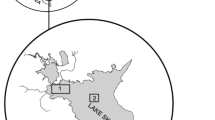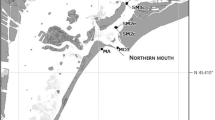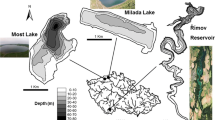Abstract
Abundance, growth, habitat and food choice of young-of-the-year (Y-O-Y) freshwater fishes were investigated in a gradient of eutrophication in a Baltic inlet. Secchi-disc depth decreased from 3 to 0.5 m along the gradient with an accompanying reduction in submerged vegetation coverage. There were positive trends in Y-O-Y abundance with increasing turbidity for cyprinids, pikeperch, ruffe and smelt, and a negative trend for perch, leading to a shift from a perch dominated community in the reference area to a cyprinid dominated in the eutrophic area. The species composition of adult fishes resembled the Y-O-Y species community, indicating that community structure was determined already during early juvenile interval. Perch and cyprinid Y-O-Y preferred areas with submerged macrophytes while pikeperch and smelt were found more frequently in open waters. Perch Y-O-Y growth was reduced in eutrophic areas compared to references, especially in the size range where they change from foraging on zooplankton to benthic organisms. The deterioration of visual conditions caused by high turbidity is suggested to be negative for feeding of perch especially in deeper water. There was no evident growth reduction for pikeperch, which may be explained by a visual physiology well adapted to turbid conditions. The combined effects of turbidity and competition for food resources on growth and survival in eutrophic waters are discussed.
Similar content being viewed by others
References cited
Ahlbert, I.B. 1969. The organization of the cone cells in the retina of four teleosts with different feeding habits (Perca fluviatilis L., Lucioperca lucioperca L., Acerina cernua L., Coregonus albula L.). Ark. Zool. 22: 445–481.
Ali, M.A., R.A. Ryder & M. Anctil. 1977. Photoreceptors and visual pigments as related to behavioural responses and preferred habitats of perches (Perca spp.) and pike-perches (Stizostedion spp.). J. Fish. Res. Board Can. 34: 1475–1480.
Andersson, J., K. Mo & S. Thörnqvist. 1999. Biologisk recipientkontroll vid kärnkraftverken. Årsrapport för 1998 (Biological monitoring at the nuclear power plants in Sweden in 1998). Fiskeriverket Rapport, 4. 79 pp.
Anttila, R. 1973. Effect of sewage on the fish fauna in the Helsinki area. Oikos 15: 226–229.
Bergman, E. 1988. Foraging abilities and niche breadths of two percids, Perca fluviatilis and Gymnocephalus cernuum under different environmental conditions. J. Anim. Ecol. 57: 443–453.
Bonsdorff, E. & H. Pearson. 1999. Variation in the sublittoral macrozoobenthos of the Baltic Sea along environmental gradients: a functional-group approach. Austral. J. Ecol. 24: 312–326.
Byström, P. & E. Garcia-Berthou. 1999. Density dependent growth and size specific competitive interactions in young fish. Oikos 86: 217–232.
Dabrowski, K.R. 1982. The influence of light intensity on feeding of fish larvae and fry II. Rutilus rutilus (L.) and Perca fluviatilis (L.). Zool. Jahrb. Physiol. 86: 353–360.
Diehl, S. 1988. Foraging efficiency of three freshwater fish: effects of structural complexity and light. Oikos 53: 207–214.
Hargeby, A., G. Andersson, I. Blindow & S. Johansson 1994. Trophic web structure in a shalloweutrophic lake during a dominance shift from phytoplankton to submerged macrophytes. Hydrobiologia 279/280: 83–90.
Hansson, S. 1987. Effects of pulp and paper mill effluents on coastal fish communities in the Gulf of Bothnia. Ambio 16: 344–348.
Hartmann, J. 1977. Fischereiliche Veränderungen in Kulturbedingt eutrophierenden Seen. Schweiz. Z. Hydrol. 39/2: 243–254.
Hewett, S.W. & B.L. Johnson 1992. Fish bioenergetics model 2: an upgrade of a generalized model for microcomputers. University of Wisconsin, Sea Grant Institute, Technical Report WIS-SG-87-245, Madison.
Hudd, R., L. Urho & M. Hildén. 1983. Occurrence of burbot, Lota lota L., larvae at the mouth of the river Kyrönjoki in Kvarken, Gulf of Bothnia. Aqui. Ser. Zool. 22: 127–130.
Janssen, J. 1997. Comparison of response distance to prey via the lateral line in the ruffe and yellow perch. J. Fish Biol. 51: 921–930.
Jansson, A.M. & N. Kautsky. 1977. Quantitative survey of hard bottom communities in a Baltic archipelago. pp. 359–366. In: B.F. Keegan, P.O. Ceidigh & P.J.S. Boaden (ed.) Biology of Benthic Organisms, Pergamon Press, Oxford.
Jeppesen, E., M. Sondergaard, E. Kastrup, B. Petersen, R.B. Hammershoj, E. Mortensen, J.P. Jensen & A. Have. 1994. Does the impact of nutrients on the biological structure and function of brackish and freshwater lakes differ? Hydrobiologia 276: 15–30.
Johnston, T.A. 1999. Factors affecting food consumption and growth of walleye, Stizostedion vitreum, larvae in culture ponds. Hydrobiologia 400: 129–140.
Karås, P. 1984. Födovalet hos fisk i Biotestsjön, Forsmark, under åren 1978-1983 (Food choice of fish from the Biotest basin, Forsmark, in the years of 1978-1983.) Naturvårdsverket, Meddelande SNV PM 1913, 33 pp.
Karås, P. 1996a. Recruitment of perch (Perca fluviatilis L.) from Baltic coastal waters. Arch. Hydrobiologia 138: 99–121.
Karås, P. 1996b. Basic abiotic conditions for production of perch (Perca fluviatilis L.) young-of-the-year in the Gulf of Bothnia. Ann. Zool. Fenn. 33: 371–381.
Karås, P. & E. Neuman. 1981. First year growth of perch (Perca fluviatilis L.) and roach (Rutilus rutilus (L.)) in a heated Baltic Bay. Rep. Inst. Freshw. Res. Drottningholm 59: 48–63.
Karås, P. & G. Thoresson. 1992. An application of a bioenergetics model to Eurasian perch (Perca fluviatilis L.). J. Fish Biol. 41: 217–230.
Kudrinskaya, O.I. 1973. Weight length ratio in certain fish larvae. Hydrobiol J. 9: 52–54.
Lantry, B.F. 1997. Bioenergetic allometries of percids and gizzard shad: implications for estimating predation on the changing prey assemblage in Oneida Lake, NY. Ph.D. Thesis, State University of New York, Ithaca. 123 pp.
Lantry, B.F & D.J. Stewart. 1993. Ecological energetics of rainbow smelt in the Laurentian Great Lakes - an interlake comparision. Trans. Amer. Fish. Soc. 122: 951–976.
Lappalainen, J. & H. Lehtonen. 1995. Year-class strength of pikeperch (Stizostedion lucioperca L.) in relation to environmental factors in a shallow Baltic bay. Ann. Zool. Fennici. 32: 411–419.
Larsson, S. & I. Berglund. 1997. Growth and food consumption of 0+ Artcic charr fed pelleted or natural food at six different temperatures. J. Fish Biol. 52: 230–242.
Lei, C.-H. & K.B. Armitage. 1980. Ecological energetics of a Daphnia ambigua population. Hydrobiologia 70: 133–143.
Luther, H. 1951. Verbreitung und Ökologie der höheren Wasserpflanzen im Brackwasser der Ekenäs-Gegend in Südfinland. I. Allgemeiner Teil. Acta. Bot. Fennica 49: 1–231.
Mehner, T. & R. Thiel. 1999. A review of predation impact on zooplankton in fresh and brackish waters of the temperate northern hemisphere. Env. Biol. Fish. 56: 169–181.
Neuman, E. 1976. The growth and year-class strength of perch (Perca fluviatilis L.) in some Baltic Archipelagos, with special reference to temperature. Rep. Inst. Freshw. Res. Drottningholm 55: 51–70.
Neuman, E. 1987. Inverkan av avloppsvatten från skogsindustrier på fisksamhällen. En utvärdering av svenska undersökningar (Pulp mill effluent effects on fish communities - a critical review of Swedish studies.) Naturvårdsverket Rapport 3325. 78 pp.
Persson, L. 1987. Competition-induced switch in young-of-the-year perch, Perca fluviatilis: an experimental test of resource limitation. Env. Biol. Fish. 19: 235–239.
Persson, L. 1988. Asymmetries in competitive and predatory interactions in fish populations. pp. 203–218. In: B. Ebenmann & L. Persson (ed.) Size-structured Populations: Ecology and Evolution, Springer Verlag, Berlin.
Persson, L. & L.A. Greenberg. 1990. Competitive juvenile bottlenecks: the perch (Perca fluviatilis) - roach (Rutilus rutilus) interaction. Ecology 71: 44–56.
Persson, L. & L. Johansson. 1992. On competition and temporal variation in temperate freshwater fish populations. Neth. J. Zool. 42: 304–322.
Persson, L., S. Diehl, L. Johansson, G. Andersson & S.F. Hamrin. 1991. Shifts in fish communities along the productivity gradient of temperate lakes - patterns and the importance of size-structured interactions. J. Fish Biol. 38: 281–293.
Persson, L., S. Diehl, L. Johansson, G. Andersson & S.F. Hamrin. 1992. Trophic interactions in temperate lake ecosystems: a test of food chain theory. Amer. Nat. 140: 59–84.
Rosenberg, R. 1984. Biologisk värdering av grunda svenska havsområden. Fisk och bottendjur (Biological assessment of Swedish shallowmarine areas. Fish and benthic fauna). Statens naturvårdsverk SNV PM 1911. 384 p.
Sandström, O., I. Abrahamsson, J. Andersson & M. Vetemaa. 1997. Temperature effects on spawning and egg development in Eurasian perch. J. Fish Biol. 51: 1015–1024.
Stewart, D.J., D. Weiniger, D.V. Rottiers & T.A. Edsall. 1983. An energetics model for lake trout, Salvelinus namaycusch: application to the lake Michigan population. Can. J. Fish. Aquat. Sci. 40: 681–698.
Svedäng, H. & P. Karås. 1993. Utsläpp av kylvatten - en möjlighet att förbättra fiskrekrytering? (Discharge of cooling water - a possibility to improve fish recruitment?) Fiskeriverket, Kustrapport 1993: 540 pp.
Thoresson, G. 1996. Guidelines for coastal fish monitoring. Fiskeriverket Kustrapport 1996: 2. 34 pp.
Townsend, C.-R. & A.J. Risebrow 1982. The influence of light level on the functional response of a zooplanktivorous fish. Oecologia 53: 293–295.
Urho, L. 1996. Habitat shifts of perch larvae as survival strategy. Ann. Zool. Fenn. 33: 329–340.
Urho, L., M. Hildén & R. Hudd 1990. Fish reproduction and the impact of acidification in the Kyrönjoki River estuary in the Baltic Sea. Env. Biol. Fish. 27: 273–283.
Vijverberg J. & Th.H. Frank 1976. The chemical composition and energy contents of copepods and cladocerans in relation to their size. Freshwater Biol. 6: 333–345.
Wang, N. 1994. Laboratory studies on factors affecting the early life history of perch. pp. 2–26. In: On the Ecology of Age-0 Perch (Perca fluviatilis L.) in Lake Constance, Doctoral Dissertation, University of Konstanz, Hartung-Gorre Verlag, Konstanz.
Winfield, I.J. 1986. The influence of simulated aquatic macrophytes on the zooplankton consumption rate of juvenile roach, Rutilus rutilus, rudd, Scardinius erythrophthalmus, and perch, Perca fluviatilis. J. Fish Biol. 29(Suppl. A): 37–48.
Wulff, F., G. Aertebjerg, G. Nicolaus, P. Niemi, P. Ciszewski, S. Schultz & W. Kaiser. 1986. The changing pelagic ecosystem of the Baltic Sea. Ophelia suppl. 4: 299–319.
Author information
Authors and Affiliations
Rights and permissions
About this article
Cite this article
Sandström, A., Karås, P. Effects of Eutrophication on Young-of-the-year Freshwater Fish Communities in Coastal Areas of the Baltic. Environmental Biology of Fishes 63, 89–101 (2002). https://doi.org/10.1023/A:1013828304074
Issue Date:
DOI: https://doi.org/10.1023/A:1013828304074




